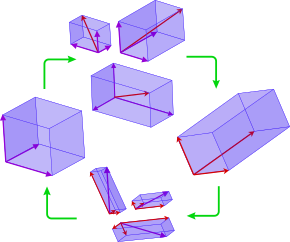
A | B | C | D | E | F | G | H | CH | I | J | K | L | M | N | O | P | Q | R | S | T | U | V | W | X | Y | Z | 0 | 1 | 2 | 3 | 4 | 5 | 6 | 7 | 8 | 9
This article needs additional citations for verification. (November 2017) |
In mathematics, an ordered basis of a vector space of finite dimension n allows representing uniquely any element of the vector space by a coordinate vector, which is a sequence of n scalars called coordinates. If two different bases are considered, the coordinate vector that represents a vector v on one basis is, in general, different from the coordinate vector that represents v on the other basis. A change of basis consists of converting every assertion expressed in terms of coordinates relative to one basis into an assertion expressed in terms of coordinates relative to the other basis.[1][2][3]
Such a conversion results from the change-of-basis formula which expresses the coordinates relative to one basis in terms of coordinates relative to the other basis. Using matrices, this formula can be written
where "old" and "new" refer respectively to the firstly defined basis and the other basis, and are the column vectors of the coordinates of the same vector on the two bases, and is the change-of-basis matrix (also called transition matrix), which is the matrix whose columns are the coordinates of the new basis vectors on the old basis.
This article deals mainly with finite-dimensional vector spaces. However, many of the principles are also valid for infinite-dimensional vector spaces.
Change of basis formula
Let be a basis of a finite-dimensional vector space V over a field F.[a]
For j = 1, ..., n, one can define a vector wj by its coordinates over
Let
be the matrix whose jth column is formed by the coordinates of wj. (Here and in what follows, the index i refers always to the rows of A and the while the index j refers always to the columns of A and the such a convention is useful for avoiding errors in explicit computations.)
Setting one has that is a basis of V if and only if the matrix A is invertible, or equivalently if it has a nonzero determinant. In this case, A is said to be the change-of-basis matrix from the basis to the basis
Given a vector let be the coordinates of over and its coordinates over that is
(One could take the same summation index for the two sums, but choosing systematically the indexes i for the old basis and j for the new one makes clearer the formulas that follows, and helps avoiding errors in proofs and explicit computations.)
The change-of-basis formula expresses the coordinates over the old basis in terms of the coordinates over the new basis. With above notation, it is
In terms of matrices, the change of basis formula is
where and are the column vectors of the coordinates of z over and respectively.
Proof: Using the above definition of the change-of basis matrix, one has
Antropológia
Aplikované vedy
Bibliometria
Dejiny vedy
Encyklopédie
Filozofia vedy
Forenzné vedy
Humanitné vedy
Knižničná veda
Kryogenika
Kryptológia
Kulturológia
Literárna veda
Medzidisciplinárne oblasti
Metódy kvantitatívnej analýzy
Metavedy
Metodika
Text je dostupný za podmienok Creative
Commons Attribution/Share-Alike License 3.0 Unported; prípadne za ďalších
podmienok.
Podrobnejšie informácie nájdete na stránke Podmienky
použitia.
www.astronomia.sk | www.biologia.sk | www.botanika.sk | www.dejiny.sk | www.economy.sk | www.elektrotechnika.sk | www.estetika.sk | www.farmakologia.sk | www.filozofia.sk | Fyzika | www.futurologia.sk | www.genetika.sk | www.chemia.sk | www.lingvistika.sk | www.politologia.sk | www.psychologia.sk | www.sexuologia.sk | www.sociologia.sk | www.veda.sk I www.zoologia.sk





























